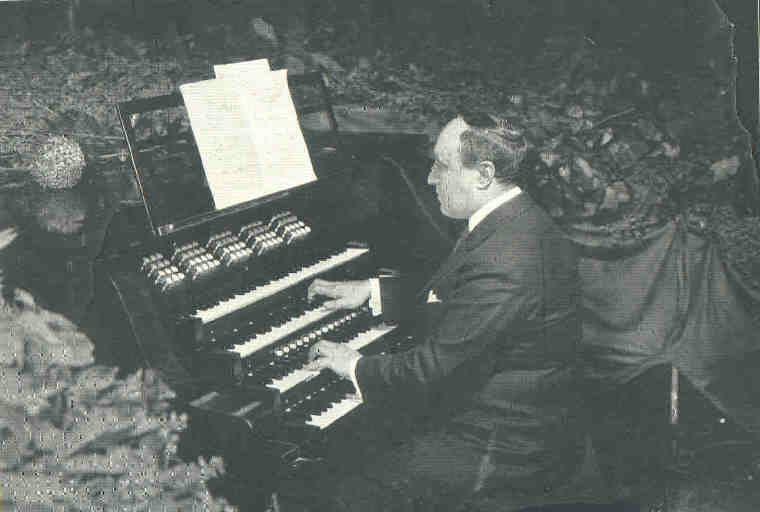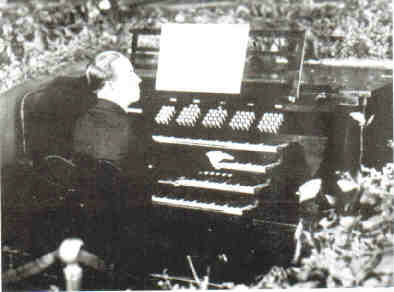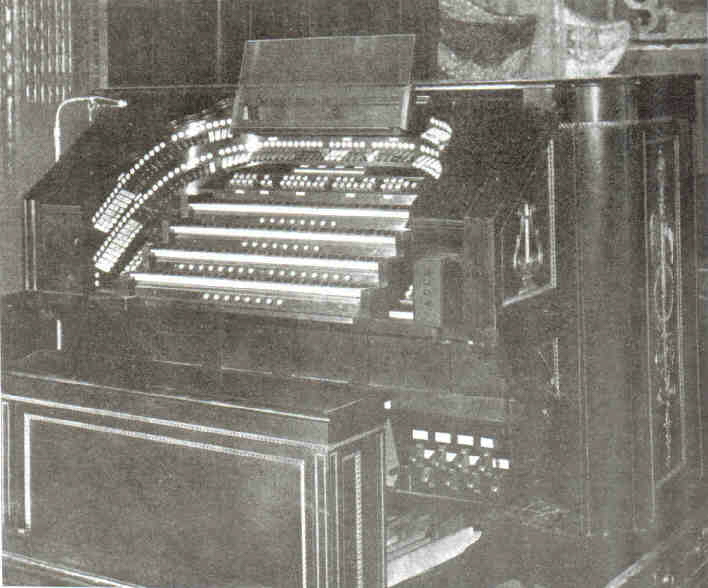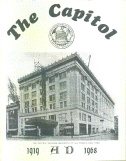The Capitol Theater
New York, NY
Opus 1710-2651


De. Melchiorre Mauro-Cottone |

C.A.J. Parmentier |

Opus 1710 - 1919
Luminous Console added in 1923
Organ rebuilt in 1927 as Opus 2651
|
Great Organ
16 Diapason
16 Tibia Clausa*
8 1st Diapason
8 2nd Diapason
8 Doppel Flute
8 Tibia Clauasa*
8 Dulciana
4 Octave
4 Tibia Clausa*
16 Saxophone (Orch)(TC)*
8 Trumpet
8 Saxophone (Orch)*
8 Kinura
Pedal Organ
32 Bourdon
16 Bourdon
16 Open Diapason
16 Gamba (Acc)
8 Octave
8 2nd Open Diapason (Gt)
8 Cello II
8 Dolce Flute
16 Trombone
8 Tuba
Bass Drum
Tympani (Bass Drum Roll)
Cymbal
Snare Drum Roll
16 Piano
8 Piano
Pedal 2nd Touch
Bass Drum
Cymbals
Chinese Gong
Order of Manuals
I. Accompaniment Manual
II Great Manual
II Duplex Manual
IV Solo Manual
|
Accompaniment Organ
16 Gamba
8 Major Flute
8 Clarabella
8 Gamba Celeste II
8 Viol Celeste II
8 Violins III
8 Unda Maris
4 Flauto Traverso
V Mixture
8 Cornopean
8 Vox Humana
8 Harp
8 Piano*
4 Piano*
Orchestral Division
16 Tibia Clausa*
8 Tibia Clausa*
4 Tibia Clausa*
2 2/3 Tibia Clausa*
8 Tibia Plena (Pd)*
Strings I*
8 Keen String
8 Celeste (TC)
4 Viol d'Orchestre
4 Viol Celeste
Strings II*
8 Salicional
8 Viol Celeste (TC)
4 Violina
Strings III*
8 Gemshorn
8 Gemshorn Celeste (TC)
4 Celestina
16 Trombone*
16 Saxophone (TC)*
8 Tuba
8 French Horn*
8 Saxophone*
8 Kinura*
4 Clarion*
Snare Drum Tap*
Tom-Tom*
Castanets*
Tambourine*
Chinese Block*
Chimes (Dup)
Accompaniment 2nd Touch
* 1927 Additions
|
Duplex Organ
From Accompaniment
8 Major Flute
8 Clarabella
8 First Violins III
8 Gamba Celeste II
8 Viol Celeste II
8 Major Flute
4 Flauto Traverso
8 Cornopean
Accmpaniment Tremolo
8 Harp
8 Piano
4 Piano
From Orchestral
8 Tibia Plena
Strings I
Strings II
Strings III
16 Trombone
8 Tuba
8 French Horn
8 Kinura
4 Clarion
Orchestral Tremolo
Snare Drum Roll
Tom-Tom
Castanets
Tambourine
Chinese Block
From Solo
8 Stentorphone
8 Tibia Clausa
4 Flute Harmonic
2 Piccolo
16 Contra Fagotto
16 Vox Humana
8 Tuba Mirabilis
8 Saxophone
8 English Horn
8 Orchestral Oboe
8 Bassett Horn
8 Vox Humana
Solo Tremolo
Chimes
Marimba
Xylophone
Orchestral Bells
|
Solo Organ
8 Stentorphone
8 Tibia Clausa
4 Flute Harmonic
2 Piccolo
16 Trombone (Orch)
16 Contra Fagotto*
16 Vox Humana*
8 Tuba Mirabilis
8 Tuba (Orch)
8 Saxophone
8 Orchestral Oboe
8 English Horn
8 Bassett Horn*
8 Vox Humana
4 Clarion (Orch)
Tremolo
Marimba*
Xylophone
Bar Bells
Tremolo
Couplers
Great-Accom-Solo-Duplex
Unisons
Duplex to Great 16-8-4
Accom to Great 16-8-4
Solo to Great 16-8-4
Duplex to Duplex 16-4
Solo to Duplex 16-8-4
Accom to Accom 16-4
Duplex to Accom 16-8-4
Solo to Accom 16-8-4
Solo to Solo 16-4
Great to Ped 8
Duplex to Ped 8-4
Accom to Ped 8
Solo to Ped 8
|
4 Manual Stop-Key Luminous Special
Special Massive Console Case
Shop Order # 1
Shop Order # 2
Shop Order # 3

Theatre Historical Society booklet
"We find in our largest theater, The Capital, on Broadway, New York City - and to that city I largely confine my remarks - a truly magnificent organ of four manuals, and 52 stops augmented from 37 registers (actual ranks of pipes), with 2,356 pipes, built by the Estey Organ Company. It is as good a church organ as it is a theater instrument; there are no traps, though there is some percussion work - harp and chimes. Tonally, it is a work of art. I deal with the Capitol because I consider it as near the ideal as has thus far been obtained - organs, organists, and managers being as they are.
"When the Capitol was first opened it suffered the usual crime of prolonged forte and fortissimo from the organ - the sweetest voice on earth becomes a torment if it remains loud for minutes upon minutes. There were frequent changes of organists, and fluctuations in artistrv. Then the manager discovered a church organist whom he liked personally, and offered him this most coveted Broadway post. The church organist knew he couldn't do it, and declined. But theater managers get what they want. Dr. Melchiorre Mauro-Cottone accepted, and disgraced himself for an apprenticeship of several years until he gradually matured into a supreme photo-playing artist.
"Dr. Mauro-Cottone, (1885-1938) of Italian birth, is to-day a supreme theater artist; when we hear Dr. Mauro-Cottone we hear music that is beautiful, that is always appropriate, music that never offends. His playing now is a background of pianissimo, broken only by an occasional forte for relief, and a fortissimo now and then for climax. He plays no compositions formally, but uses anything and everything he wants, drawing it not from the printed sheet, but from his copious memory, using as many pages or as few measures as he likes, moulding one piece into another by the aid of his fine musicianship and his ability to improvise by the hour; I doubt if he improvises strictly his own music for more than a few minutes at a time, just as I doubt if he plays one composition or theme for more than a few minutes at a time. His is the perfect school of fitting organ music to pictures - providing you have a tremendous memory, the ability to improvise entertainingly by the hour, and a liking for the job that never deserts you."
From: New York and the Cinema, by Scott Buhrman, editor of The American Organist
(published in "The Complete Organ Recitalist", ed. Herbert Westerby, London, 1927, pp. 347-354)
Shop Order (1927)
"Encylopedia of the American Theatre Organ", David L. Junchen



